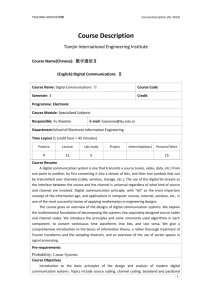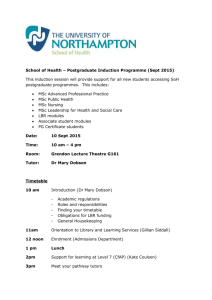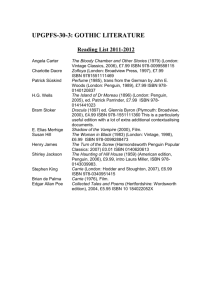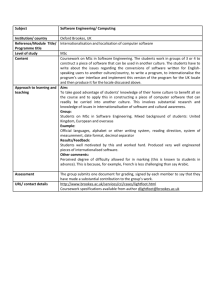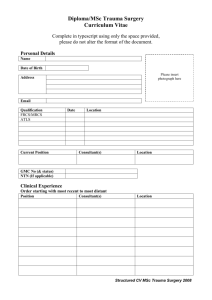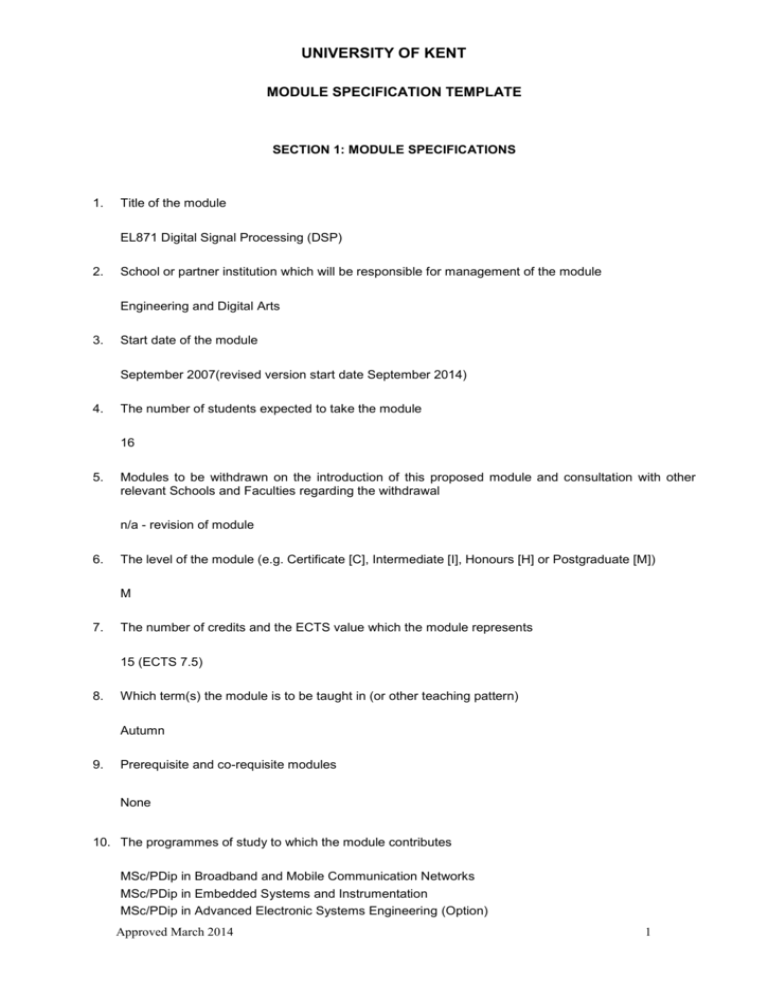
UNIVERSITY OF KENT
MODULE SPECIFICATION TEMPLATE
SECTION 1: MODULE SPECIFICATIONS
1.
Title of the module
EL871 Digital Signal Processing (DSP)
2.
School or partner institution which will be responsible for management of the module
Engineering and Digital Arts
3.
Start date of the module
September 2007(revised version start date September 2014)
4.
The number of students expected to take the module
16
5.
Modules to be withdrawn on the introduction of this proposed module and consultation with other
relevant Schools and Faculties regarding the withdrawal
n/a - revision of module
6.
The level of the module (e.g. Certificate [C], Intermediate [I], Honours [H] or Postgraduate [M])
M
7.
The number of credits and the ECTS value which the module represents
15 (ECTS 7.5)
8.
Which term(s) the module is to be taught in (or other teaching pattern)
Autumn
9.
Prerequisite and co-requisite modules
None
10. The programmes of study to which the module contributes
MSc/PDip in Broadband and Mobile Communication Networks
MSc/PDip in Embedded Systems and Instrumentation
MSc/PDip in Advanced Electronic Systems Engineering (Option)
Approved March 2014
1
UNIVERSITY OF KENT
MSc/PDip in Wireless Communications & Signal Processing
MEng in Computer Systems Engineering
MEng in Computer Systems Engineering with a Year in Industry
MSc/PDip Engineering with Finance
11. The intended subject specific learning outcomes
On successful completion of this module, a student will:
1. Have an understanding of the basic principles of Digital Signals in both the time and frequency
domains and the ability to use the Fourier Transform, the Fast Fourier Transform and the ZTransform to analyse such signals. To understand the effects of noise on digital systems;
2. Be able to use standard methods to design filters for use in processing digital signals.
3. Understand how DSP techniques can be used in Instrumentation and Measurement, image
processing (and image compression) and modern communication systems.
These outcomes are related to the programme learning outcomes in the appropriate curriculum maps
as follows:
MSc/PDip in Broadband and Mobile Communications Networks: A1,A5, B1-B3, C1-C3
MSc/PDip in Wireless Communications and Signal Processing: A1,A5, B1-B3, C1-C3
MSc in Embedded Systems and Instrumentation: A1,A2, B2,B3, C1-C3,C6
MSc/PDip in Advanced Electronic Systems Engineering: A1,A2, B2,B3, C1-C3,C6
MSc/PDip in Engineering with Finance: A1,A2,A3, B1,B3,B5,B6, C2
MEng in CSE/CSEwInd: A1-A3,A8,A12,A13,A16, B2-B4,B10, C2,C3
12. The intended generic learning outcomes
On successful completion of this module, a student will:
1. have shown ability to generate, analyse, present and interpret data (D1).
2. be able to use ICT (D2).
3. be able to learn effectively for CPD, will use critical thinking, reasoning and reflection
and demonstrate time and resource management. (D5-D7).
These outcomes are related to the generic learning outcomes in the appropriate curriculum maps as
follows:
MSc/PDip programmes in Broadband and Mobile Communication Networks: D1-D2, D5–D7
MSc in Embedded Systems and Instrumentation: D1-D2, D5-D7
MSc/PDip in Advanced Electronic Systems Engineering: D1-D2, D5-D7
MSc/PDip programmes in Wireless Communications and Signal Processing: D1-D2, D5-D7
MSc/PDip in Engineering with Finance: D1,D2,D5-D7
MEng inCSE/CSEwInd: D1,D2 , D5-D7
13. A synopsis of the curriculum
Lecture Syllabus
SIGNALS
Introduction to signals and signal analysis. Frequency and time domain representations of signals. A
review of the Fourier Series, Fourier Transform and Laplace Transforms. Noise: definitions and
sources of noise in signal analysis.
DIGITAL SIGNAL PROCESSING
Approved March 2014
2
UNIVERSITY OF KENT
The sampling theorem, Aliasing, Anti-Aliasing and Anti-Imaging Filters, ADCs and DACs. The
Fourier Transform (FT). The Discrete Fourier Transform (DFT) and The Fast Fourier Transform
(FFT).The Z-transform. Pole-Zero placement methods for signal analysis. Transfer functions in S and
Z domains. Theory, design and performance of Finite Impulse-Response (FIR) and Infinite-ImpulseResponse (IIR) Filters. Multirate DSP. Architectures and devices for digital signal processing. Effects
of Finite Precision.
APPLICATIONS OF DSP
Processing and filtering of signals for Instrumentation and measurement, Processing and filtering of
images: DSP in modern communication systems.
Coursework
ASSIGNMENTS
The six workshop assignments use MATLAB and SIMULINK to develop and explore concepts that
have been introduced in the lectures.
14. Indicative Reading List
BENOIT, Hervé, 2002. Digital television: MPEG-1, MPEG-2, and principles of the DVB system.
Oxford: Focal Press. ISBN 0240516958.
CROCHIERE, R E., 1983. Multirate digital signal processing. S.l.: Prentice-Hall. ISBN 0136051626.
DUDGEON, D E., 1984. Multidimensional digital signal processing. S.l.: Prentice-Hall. ISBN
0136049591.
IFEACHOR, Emmanuel C. and JERVIS, Barrie W., 2002. Digital signal processing: a practical
approach. Harlow: Prentice Hall. ISBN 0201596199.
JACKSON, Leland B., 1996. Digital filters and signal processing: with MATLAB exercises. Boston:
Kluwer Academic Publishers. ISBN 079239559X.
LATHI, B. P. and DING, Zhi, 2010. Modern digital and analog communication systems. New York:
Oxford University Press. ISBN 0195331451.
LYNN, Paul A. and FUERST, Wolfgang, 1998. Introductory digital signal processing with computer
applications. Chichester: John Wiley. ISBN 0471976318.
OPPENHEIM, A V., 1978. Applications of digital signal processing. S.l.: Prentice-Hall. ISBN
0130391158.
OPPENHEIM, Alan V. and SCHAFER, Ronald W., 1975. Digital signal processing. Englewood Cliffs,
N.J.: Prentice-Hall. ISBN 0132146355.
PROAKIS, John G. and MANOLAKIS, Dimitris G., 2007. Digital signal processing. Upper Saddle
River, N.J.: Pearson Prentice Hall. ISBN 0131873741.
STREMLER, Ferrel G., 1990. Introduction to communication systems. Wokingham: Addison-Wesley.
ISBN 0201184982.
STROUD, K. A., 1996. Further engineering mathematics: programmes and problems. Basingstoke:
Macmillan. ISBN 0333657411.
STROUD, K. A. and BOOTH, Dexter J., 2001. Engineering mathematics. Basingstoke: Palgrave.
ISBN 0333919394.
STROUD, K. A. and BOOTH, Dexter J., 2007. Engineering mathematics. Basingstoke: Palgrave
Macmillan. ISBN 1403942463.
WILLIAMS, Charles Sterling, 1986. Designing digital filters. Englewood Cliffs: Prentice-Hall. ISBN
013201856x.
15. Learning and Teaching Methods, including the nature and number of contact hours and the total
study hours which will be expected of students, and how these relate to achievement of the intended
module learning outcomes
The module is taught through lectures, directed self-study and problem solving, short workshops and
laboratories. The material covered in each lecture will need some extra study to be digested, with
Approved March 2014
3
UNIVERSITY OF KENT
extra time for revision and examination, giving a required study time of 4 hours for each one of the
14 lectures. There are also 20 hours of PC-based laboratory classes and 28 hours of PC-based
laboratory workshops. There are a total of 62 student contact hours and 150 total study hours in the
module.
16. Assessment methods and how these relate to testing achievement of the intended module learning
outcomes
The module is examined through an unseen written examination (60%). This will test the
achievement of all the subject specific learning outcomes. The laboratory and workshop
assignments (40%) test these learning outcomes as well as all the generic learning outcomes.
17. Implications for learning resources, including staff, library, IT and space
None
18. The School recognises and has embedded the expectations of current disability equality legislation,
and supports students with a declared disability or special educational need in its teaching. Within
this module we will make reasonable adjustments wherever necessary, including additional or
substitute materials, teaching modes or assessment methods for students who have declared and
discussed their learning support needs. Arrangements for students with declared disabilities will be
made on an individual basis, in consultation with the University’s disability/dyslexia support service,
and specialist support will be provided where needed.
19. Campus(es) where module will be delivered:
Canterbury campus
If the module is part of a programme in a Partner College or Validated Institution, please complete
the following:
20. Partner College/Validated Institution:
21. University School responsible for the programme:
Approved March 2014
4
UNIVERSITY OF KENT
SECTION 2: MODULE IS PART OF A PROGRAMME OF STUDY IN A UNIVERSITY SCHOOL
Statement by the School Director of Learning and Teaching/School Director of Graduate Studies
(as appropriate): "I confirm I have been consulted on the above module proposal and have given advice
on the correct procedures and required content of module proposals"
................................................................
..............................................
Director of Learning and Teaching/Director of
Graduate Studies (delete as applicable)
Date
…………………………………………………
Print Name
Statement by the Head of School: "I confirm that the School has approved the introduction of the
module and, where the module is proposed by School staff, will be responsible for its resourcing"
.................................................................
..............................................
Head of School
Date
…………………………………………………….
Print Name
SECTION 3: MODULE IS PART OF A PROGRAMME IN A PARTNER COLLEGE OR VALIDATED
INSTITUTION
(Where the module is proposed by a Partner College/Validated Institution)
Statement by the Nominated Officer of the College/Validated Institution (delete as applicable): "I
confirm that the College/Validated Institution (delete as applicable) has approved the introduction of the
module and will be responsible for its resourcing"
.................................................................
..............................................
Nominated Responsible Officer of Partner
College/Validated Institution
Date
………………………………………………….
Print Name
…………………………………………………..
Post
………………………………………….
Partner College/Validated Institution
Module Specification Template
Last updated February 2013
Approved March 2014
5


